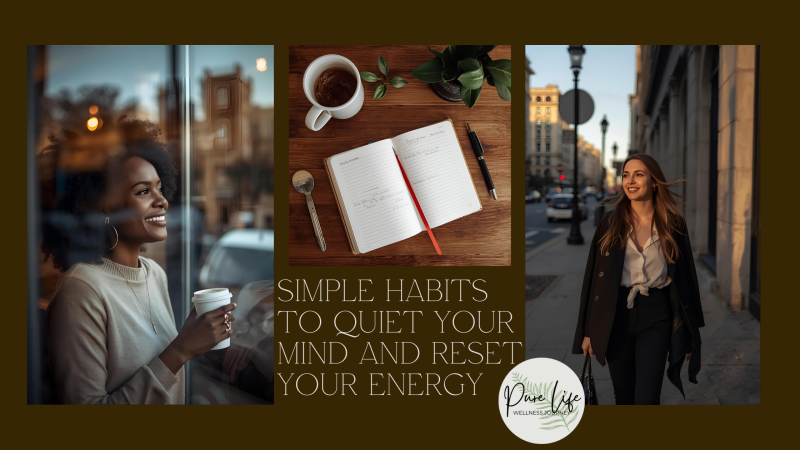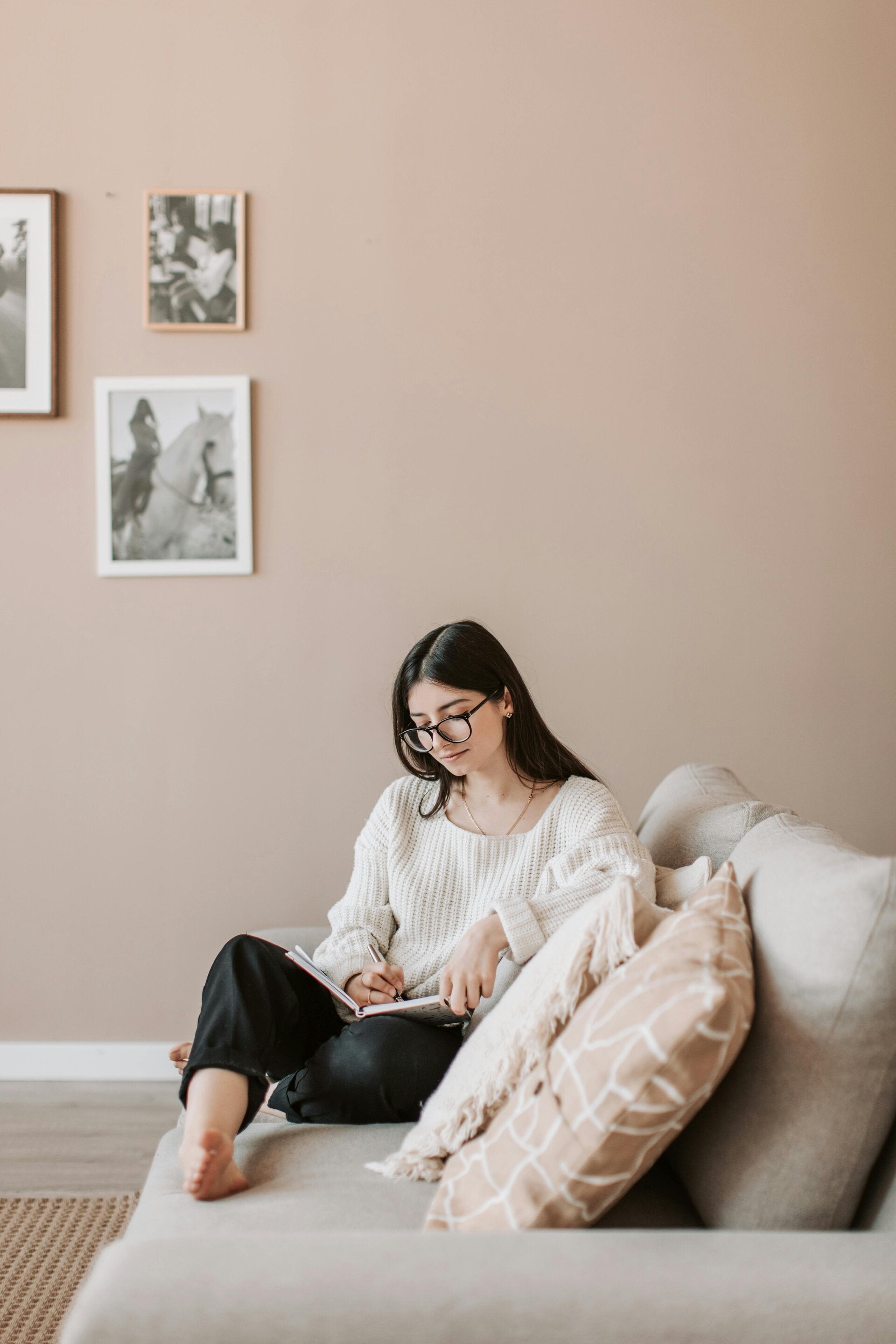
Start your Mental Health Glow Up today with our simple, step-by-step blog series designed to help you clear mental clutter, build emotional resilience, calm your nervous system, and nurture deeper connections.
Don’t wait to feel better — Keep reading!
Why Your Mind Feels Cluttered
Your mind feels cluttered when too many thoughts, worries, or distractions compete for your attention all at once. In today’s fast-paced world, constant notifications, endless to-do lists, and emotional stress create mental noise that overwhelms your brain’s natural ability to focus and process. When you don’t have space to pause, reflect, or organize your thoughts, everything feels jumbled — making it hard to think clearly or feel calm. This mental clutter can lead to feelings of overwhelm, anxiety, and exhaustion. The good news? By intentionally decluttering your mind with simple habits like journaling, setting boundaries, and taking digital breaks, you can clear that chaos and restore peace.

Clear your Mind
In our busy, constantly connected lives, mental clutter can easily take over, making it difficult to focus or feel calm. Journaling offers a simple yet powerful way to clear this clutter by helping you organize your thoughts, process emotions, and gain insight into what’s really on your mind. Setting clear boundaries—whether with work, social obligations, or even your own habits—creates essential space and protects your energy from being stretched too thin. Meanwhile, a digital detox reduces the flood of notifications, news, and social media distractions that often overwhelm the brain. By consciously unplugging, you allow your nervous system to reset and your mind to recharge. Together, these practices foster mental clarity, making it easier to prioritize, make decisions, and find peace in everyday life.

Journaling — Declutter Through Reflection
Journaling is one of the simplest yet most powerful tools for improving mental clarity and emotional well-being. Putting thoughts onto paper helps you slow down racing ideas, process emotions, and gain perspective on what’s truly going on inside. It turns abstract worries into something tangible — something you can see, understand, and release. Regular journaling has been shown to reduce anxiety, improve focus, and even enhance self-awareness. It’s a mindful practice that encourages you to pause, reflect, and reconnect with yourself in an honest, judgment-free space. Over time, journaling helps you recognize patterns, celebrate progress, and cultivate gratitude — all of which contribute to a calmer, clearer mind.
If you’re not sure how to begin, try starting small. Here are a few easy ways to make journaling part of your daily routine:
-
🕯 Start your day with a “brain dump.” Write down everything on your mind — tasks, worries, hopes — to clear mental clutter before you begin the day.
-
💭 Use guided prompts. Try questions like “What’s taking up space in my mind right now?” or “What’s one thing I can let go of today?”
-
🌙 End your day with reflection. Note what went well, what challenged you, and what you’re grateful for.
-
📅 Keep it consistent but simple. Even five minutes a day can have a big impact — consistency matters more than perfection.
-
💌 Try themed journaling. Use specific focuses like gratitude journaling, emotional check-ins, or goal tracking to deepen your practice.
Whether you prefer pen and paper, a notes app, or voice-to-text, what matters most is making space to listen to yourself. Journaling isn’t about perfect writing — it’s about creating clarity, balance, and self-awareness one page at a time.

Boundaries — Declutter Your Commitments
Setting boundaries is one of the most empowering acts of self-care you can practice for your mental health. Boundaries protect your time, energy, and emotional well-being—helping you avoid burnout and resentment. They create the space you need to rest, focus, and nurture meaningful relationships. Start by getting clear on your limits: notice what drains you, what feels overwhelming, and where you often say “yes” when you mean “no.” Communicate your needs with honesty and kindness—simple statements like “I won’t be available after 6 p.m.” or “I need some time to recharge tonight” are powerful and respectful. Remember, you don’t have to explain or apologize for your boundaries. Consistency is key—upholding them reinforces your self-respect and teaches others how to treat you. Over time, boundaries transform from guilt-inducing to liberating, allowing you to feel calmer, more in control, and truly aligned with your priorities.
💼 Work Boundaries
-
Set clear work hours — and stick to them. Turn off notifications after your workday ends.
-
Learn to say “I’ll get to that tomorrow” instead of overloading your schedule.
-
Take regular breaks to step away from screens and reset your focus.
💞 Relationship Boundaries
-
Communicate openly when you need space or quiet time — it’s not rejection, it’s self-care.
-
Decline invitations when you’re stretched thin without feeling guilty.
-
Avoid emotional overextension by recognizing when someone’s problems are not yours to solve.
🌱 Personal & Digital Boundaries
-
Limit phone use during meals or before bed to protect your mental clarity.
-
Schedule “no screen” hours and replace them with reading, journaling, or outdoor time.
-
Create physical and emotional downtime — even 15 minutes of solitude can recharge your energy.

Digital Detox — Declutter Your Inputs
Why Limiting Screen Time Matters for Your Mental Health
In a world where our phones are rarely out of reach, constant screen time can quietly drain our mental energy. Every notification, message, and scroll keeps your brain in a state of mild alert, making it harder to concentrate, relax, and truly rest. Overexposure to screens—especially social media—can also heighten comparison, stress, and information overload, leaving you mentally scattered. By setting limits on screen use, you give your mind the opportunity to recharge and refocus. Unplugging, even briefly, allows your nervous system to settle, improves sleep quality, and opens space for real-world connections and creative thinking. In short, reducing screen time isn’t about restriction—it’s about reclaiming presence, balance, and peace of mind.
Remember, the goal is balance, not perfection. Enjoy the calm and clarity that comes with a mindful digital detox.
-
Set Boundaries
Decide on no-device zones, like the bedroom or dining area. -
Schedule Screen-Free Time
Dedicate time each day to unplug, whether it’s during meals or before bed. -
Turn Off Notifications
Silence non-essential alerts to reduce distractions. -
Practice Mindfulness
Engage in activities like reading, meditation, or a nature walk. -
Limit Social Media
Set a daily limit for social media use and stick to it. -
Engage in Offline Hobbies
Rediscover hobbies you love, like painting, cooking, or playing a musical instrument. -
Connect Face-to-Face
Spend quality time with family and friends without digital interruptions. -
Reflect and Adjust
At the end of the week, reflect on your experience and make adjustments for the future.



Add comment
Comments